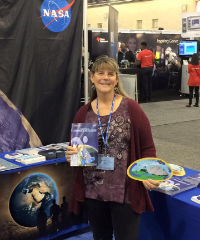Community Blogs
Community Blogs
Discover how the GLOBE community is engaging in all things GLOBE through the community blog posts below.
Learn how to create a GLOBE community blog post.
Filter By:
Blogs List
One of the important aspects of a scientist's job is to look at the data that was collected and try to make sense of it in order to better understand natural phenomena. With the ENSO Student Research Campaign, we have a unique opportunity to analyze data and use the analysis to help us better understand the impact of the ENSO cycles on weather and climate in locations all around the world.
I was looking at some of the data that many of our wonderful GLOBE teachers have sent during the ENSO campaign, and I noticed that we had data analyses sent to us from different ...
Read More »
Posted in:
Curriculum:
SCIENCE AND MATH
Event Topics:
CAMPAIGNS AND PROJECTS (IOPS, ETC)
Field Campaigns:
EL NIÑO
GLOBE Science Topics:
EARTH AS A SYSTEM
SCIENTIST SKILLS
EARTH SYSTEM SCIENCE
CLIMATE CHANGE
CLIMATE
Investigation Areas:
ATMOSPHERE
EARTH AS A SYSTEM
HYDROSPHERE
News Topics:
SCRC RESEARCH
Primary Audience:
TEACHERS
STUDENTS
SCIENTISTS
ALUMNI
There will be a special Google hangout for GLOBE teachers and scientists on Feb 15 at 7pm (ET ). During this event, we will learn about the results of the research from several scientists who were onboard the research vessel, and will have a chance to ask questions about this work and results. http://bit.ly/2lL4Kgd
No registration required- open to any GLOBE teacher and/or scientist! Please share this!
GLOBE Educator Webinar - Feb 15, 7pm ET
Agenda below:
Overview (~45 min program)
Learn about an ongoing Earth science expedition with NASA scientists ...
Posted in:
Curriculum:
SCIENCE AND MATH
TECHNOLOGY
Event Topics:
CAMPAIGNS AND PROJECTS (IOPS, ETC)
Field Campaigns:
EL NIÑO
GLOBE Science Topics:
EARTH AS A SYSTEM
EARTH SYSTEM SCIENCE
SCIENTIST SKILLS
GENERAL SCIENCE
CLIMATE CHANGE
CLIMATE
Investigation Areas:
ATMOSPHERE
EARTH AS A SYSTEM
HYDROSPHERE
BIOSPHERE
Learning Activities:
EARTH AS A SYSTEM
ATMOSPHERE AND CLIMATE
HYDROLOGY
News Topics:
SCRC RESEARCH
Primary Audience:
TRAINERS
TEACHERS
PARTNERS
SCIENTISTS
ALUMNI
COUNTRY COORDINATORS
ENSO Student Research Campaign Students in the United States, here is where you take your GLOBE date to the next level!
The US Student Research Symposium is ready to learn all about the data that you have taken!
https://www.globe.gov/web/united-states-of-america/student-research-symposia
Teachers, if you are interested in attending with a group of students, please indicate your interest and apply for funding through this Google Form by February 27th, 2017 . Funding decisions will be made by March 27th, 2017.
Posted in:
Field Campaigns:
EL NIÑO
SMAP
GLOBE Science Topics:
EARTH SYSTEM SCIENCE
Investigation Areas:
EARTH AS A SYSTEM
HYDROSPHERE
PEDOSPHERE (SOIL)
ATMOSPHERE
BIOSPHERE
Primary Audience:
TEACHERS
STUDENTS
GLOBE Partner the University Corporation for Atmospheric Research Center for Science Education developed 9 classroom activities to help students learn how to analyze GLOBE environmental data while also learning atmospheric science concepts and geography.
These new activities have been reviewed by science educators and staff at the GLOBE Implementation Office and, of course, they have been field tested by teachers.
I have gathered them up and linked them here. If you are going to the 2017 South Dakota Math and Science Teachers conference in Huron, this is what we will be ...
Posted in:
Curriculum:
SCIENCE AND MATH
Event Topics:
WORKSHOPS
GLOBE Science Topics:
SCIENTIST SKILLS
EARTH SYSTEM SCIENCE
Primary Audience:
TEACHERS
One of NASA's scientists, Dr. Stephanie Uz, has been working closely with the GLOBE ENSO Campaign throughout its beginning. She is an oceanographer who studies the response of ocean biology to physical forcing through remotely sensed satellite data, in situ measurements, model output and statistical reconstructions using proxies. Her research focuses on variability in global ocean color or chlorophyll concentrations, the pigment in microscopic phytoplankton, and the physical mechanisms causing those changes. Dr. Uz coordinates communication for the Plankton, Aerosol, Cloud, ocean ...
Posted in:
Curriculum:
EDUCATION RESEARCH
SCIENCE AND MATH
TECHNOLOGY
Field Campaigns:
EL NIÑO
GLOBE Science Topics:
EARTH AS A SYSTEM
SCIENTIST SKILLS
EARTH SYSTEM SCIENCE
CLIMATE CHANGE
CLIMATE
Investigation Areas:
ATMOSPHERE
EARTH AS A SYSTEM
HYDROSPHERE
BIOSPHERE
Learning Activities:
EARTH AS A SYSTEM
ATMOSPHERE AND CLIMATE
HYDROLOGY
Primary Audience:
TRAINERS
TEACHERS
STUDENTS
PARTNERS
SCIENTISTS
ALUMNI
COUNTRY COORDINATORS
Teacher's Guide:
INVESTIGATION AREA DOCUMENTS
In most scientific research an important test is whether the results of an experiment can be repeated, typically repeated by another lab and research group. A result that cannot be confirmed in this way is generally viewed as invalid. This is a great test for controlled experiments where virtually identical experimental conditions may be achieved.
In Earth science research involving observations of the natural world, experimental conditions cannot be reproduced. For environmental research the standard must switch for repeatable to intercomparable – capable of being compared. ...
Posted in:
GLOBE Science Topics:
GENERAL SCIENCE
EARTH SYSTEM SCIENCE
BACKYARD SCIENCE
GLOBE PROTOCOLS
Investigation Areas:
HYDROSPHERE
PEDOSPHERE (SOIL)
ATMOSPHERE
BIOSPHERE
Primary Audience:
TRAINERS
TEACHERS
STUDENTS
SCIENTISTS
ALUMNI
There are many application for SMAP soil moisture satellite data.
Understanding drought risk is vital to the health of the planet and to the lives of potentially billions of people around the world. Soil moisture strongly affects plant growth and hence agricultural productivity, especially during conditions of water shortage and drought. Currently, there is no global in situ network for soil moisture monitoring. Global estimates of soil moisture and plant water stress must be derived from models. These model predictions (and hence drought monitoring) can be greatly enhanced through ...
Posted in:
Field Campaigns:
SMAP
GLOBE Science Topics:
EARTH SYSTEM SCIENCE
Investigation Areas:
SOIL MOISTURE - SMAP BLOCK PATTERN
PEDOSPHERE (SOIL)
Primary Audience:
TEACHERS
TRAINERS
STUDENTS
PARTNERS
SCIENTISTS
ALUMNI
COUNTRY COORDINATORS
Guest Blog by NASA SMAP Scientists Dr. Erika Podest and Dr. Narendra Das of the NASA Jet Propulsion Laboratory in Pasadena, California USA.
SMAP scientists are using soil moisture in a number of ways, ways that allow all of us to better understand water’s role on Earth:
Weather Prediction : Water in the soil has the potential to evaporate (depending on atmospheric temperature and pressure) and when it does it plays a large role in cloud formation. Soil moisture also has a modulating effect on air temperature and humidity therefore having the ability to measure soil moisture ...
Posted in:
Field Campaigns:
SMAP
GLOBE Science Topics:
EARTH AS A SYSTEM
SCIENTIST SKILLS
EARTH SYSTEM SCIENCE
GENERAL SCIENCE
GLOBE PROTOCOLS
Investigation Areas:
PEDOSPHERE (SOIL)
Primary Audience:
TRAINERS
TEACHERS
STUDENTS
PARTNERS
SCIENTISTS
ALUMNI
COUNTRY COORDINATORS
Have you ever wondered how the SMAP satellite, with an altitude of 685 km (425 miles) above the Earth, can take measurements as precise as the amount of water in the Earth's soil?
The quick answer is that it requires precisely calibrated instruments, along with a technological marvel in satellite design.
SMAP was designed to use a combination of two precise instruments, one with high resolution, one with high accuracy.
THE INSTRUMENTS:
Active (High Resolution): SMAP’s radar was designed accurately measure the echoes of very short radio frequency (RF) pulses that bounce ...
Posted in:
Curriculum:
SCIENCE AND MATH
TECHNOLOGY
Field Campaigns:
SMAP
GLOBE Science Topics:
EARTH SYSTEM SCIENCE
Investigation Areas:
PEDOSPHERE (SOIL)
Primary Audience:
TRAINERS
TEACHERS
STUDENTS
PARTNERS
SCIENTISTS
ALUMNI
COUNTRY COORDINATORS
Most trees obtain water through their massive root systems, but did you know that some trees can absorb water through their leaves as well? This ability is called foliar uptake. Scientists recently discovered that trees in cloud forests use foliar uptake to obtain water. A cloud forest is a forest that has persistent or seasonally persistent fog or low-level cloud cover. Cloud forests are usually in the tropics or subtropics, have evergreen trees (trees that don’t lose their leaves) and tend to have a lot of mosses and vegetation in the understory of the trees.
Cloud Forest ...
Posted in:
GLOBE Science Topics:
EARTH SYSTEM SCIENCE
Investigation Areas:
EARTH AS A SYSTEM
BIOSPHERE
GLOBE’s Earth as a System investigation area cultivates students’ awareness of an intricate web of global connections. Similar to real world scientists, students explore life science concepts, learning that “ organisms can only survive where their needs are met. ” The Earth as a System investigation area encourages students to observe patterns and connections, such as through phenology. Phenology is the study of how living organisms respond to seasonal changes in their environment. Only through observing and measuring can we notice if changes are occurring and how they occur. ...
Posted in:
GLOBE Science Topics:
EARTH SYSTEM SCIENCE
Investigation Areas:
EARTH AS A SYSTEM
All over the United States, spring flowers such as daffodils and crocuses began blooming nearly a month ago due to an unseasonably warm winter. Some of my friends from many parts of the country have been mentioning how beautiful their gardens are and enjoying the warm weather. Even my family and friends from the Mid-Atlantic region have been sending photos showing off their beautiful home gardens.
Daffodils in bloom in late February
Many think it’s really nice to see green grass, budding trees, and flowers in bloom in late February, as it’s a spirit lift ...
From January 22 to 26, 2012, scientists from around the world gathered for the American Meteorological Society annual meeting, which was held in New Orleans, Louisiana. Scientists from the GLOBE Program stayed next to the beautiful Mississippi River.
The Mississippi River in New Orleans (photo courtesy of Dr. Donna Charlevoix)
The Mississippi River is the lifeblood of New Orleans and has so impacted the city that the city was actually developed around it. The first buildings were constructed around the river edge, which has the highest ground, and now ...
Posted in:
GLOBE Science Topics:
EARTH SYSTEM SCIENCE
GLOBE PROTOCOLS
Investigation Areas:
HYDROSPHERE
Primary Audience:
STUDENTS
This week we’ll finish our look at the climate summaries for each GLOBE region with a focus on the Near East-North Africa region. Remember that these annual reports provide a summary of the global climatic conditions and are a great benchmark for monitoring climate.
Regional reports provide a tremendous amount of information. The temperature and precipitation climate summaries are highlighted here, but if you are interested, more information about the Near East-North Africa region state of the climate is available from this website: ...
This week we’ll continue our look at the climate summaries for each GLOBE region, with a focus on the North America region. These annual reports provide a summary of the global climatic conditions and are a great benchmark for monitoring climate.
Regional reports provide a tremendous amount of information. The temperature and precipitation climate summaries are highlighted here, but if you are interested, more information about the North America Region state of the climate is available from this website: ...
This week we’ll continue our look at the climate summaries for each GLOBE region, with a focus on the Latin America-Caribbean region. Remember that these annual reports provide a summary of the global climatic conditions and are a great benchmark for monitoring climate. You can use this data in your own GLOBE climate research projects!
Regional reports provide a tremendous amount of information including temperature, precipitation, tropical cyclone activity, and notable events. Temperature and precipitation climate summaries are highlighted here; more information about the ...
This week we’ll continue our look at the climate summaries for each GLOBE region, with a focus on the Europe-Eurasia region. Recall that these annual reports provide a summary of the global climatic conditions and are a great benchmark for monitoring climate.
Regional reports provide a tremendous amount of information. The temperature and precipitation climate summaries are highlighted here, but if you are interested, more information about the Europe-Eurasia Region state of the climate is available from this website: ...
This week we’ll continue our look at the climate summaries for each GLOBE region, with a focus on the Asia-Pacific region. Recall that these annual reports provide a summary of the global climatic conditions and are a great benchmark for monitoring climate.
Regional reports provide a tremendous amount of information. The temperature and precipitation climate summaries are highlighted here, but if you are interested, more information about the Asia-Pacific Region state of the climate is available from this website: ...
In a recent blog post , we shared with you the NOAA State of the Climate report for 2010. These annual reports provide a summary of the global climatic conditions and are a great benchmark for monitoring climate. Along with the global summary, the report summarizes regions. The regions very closely overlap with the GLOBE Regions! We will go through the report and provide a summary for each GLOBE Region. A review of the Regional summaries is a great way for you to see how the climate of your region compared with the regions of other GLOBE Schools. We will start off with Africa.
All ...
Recently NOAA (National Oceanic and Atmospheric Administration) released the 2010 State of the Climate. The State of the Climate is an annual report that summarizes the climate conditions around the world over the time period of a calendar year. All the reports are available online through the National Climatic Data Center website. [ http://www.ncdc.noaa.gov/bams-state-of-the-climate/2010.php ]
The annual State of the Climate is a record of the conditions around the globe and provides an excellent reference for beginning studies of climate. If you are participating in the ...
—
20 Items per Page











